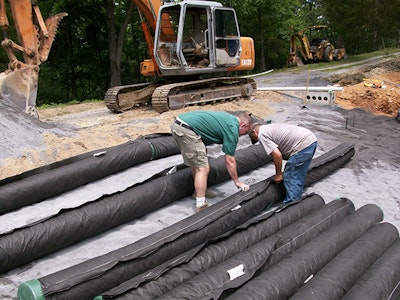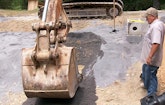
Interested in Distribution?
Get Distribution articles, news and videos right in your inbox! Sign up now.
Distribution + Get AlertsThe owner of a three-bedroom home in Ft. Blackmore, Va., wanted to sell, but the conventional drainfield was on a property next door, and that landowner would not grant an easement.
Environmental health specialist John Hyder with the Scott County Health Department evaluated the site for a new drainfield. Shallow soils and a ledge outcrop limited the dispersal area to a 30- by 50-foot section with 15 percent slope. Hyder referred the homeowner to Clifton Carson, authorized onsite soil evaluator/soil scientist at Maxim Engineering in Coeburn.
"Even if I had room for an advanced treatment tank, the absorption bed would not fit in that space," says Carson. He found his solution in the Advanced Enviro-
Septic (AES) system from Presby Environmental. The non-mechanical passive system uses combination treatment and dispersal pipes. Besides being the first installation of its kind under new state regulations allowing alternative technologies, the system saved the owner thousands of dollars over conventional designs and enabled the property to be sold.
Site conditions
Soils are silt loam and loam with a percolation rate of 40 minutes per inch and impervious layer 12 inches below grade. The lot is 110 by 450 feet.
System components
Carson designed the gravity system to handle 450 gpd. The system's major components are:
Existing 1,000-gallon single-compartment concrete septic tank
210 feet of AES treatment pipes from Presby Environmental
84 tons of System Sand
System operation
Wastewater flows by gravity to the new treatment field. Treatment occurs in perforated plastic pipes with a white Bio-Accelerator geotextile fabric along the bottom exterior surface, and a surrounding layer of green plastic fiber mat and black geotextile fabric. Ridges in the pipe allow effluent to flow uninterrupted around the circumference and cool the liquid to ground temperature. Skimmer tabs at each perforation retain grease and suspended solids, protecting the outer layers from clogging.
The Bio-Accelerator filters additional solids, speeds up treatment, facilitates quick startups, provides added surface area for bacterial growth, promotes even distribution, and protects outer layers and receiving surfaces from clogging. The mat of coarse green fibers further filters the effluent as it passes into the outer geotextile layer and grows a protected bacterial surface.
The System Sand bed wicks liquid from the geotextile fabric while transferring air to the microorganisms. The technology provides a huge bacterial surface to break down solids, while an ample air supply and fluctuating liquid levels increase bacterial efficiency. Third-party testing proved that the system treated effluent to less than 2 mg/L TSS and CBOD and to 218 CFU/100 mL fecal coliform.
Installation
Regan McMurray of McMurray Excavating in Hiltons and Donny McMurray installed the system. The septic tank was sound but needed pumping. Afterward, it remained empty, as the home was unoccupied.
McMurray did not retrofit an effluent filter because it would restrict the flow of oxygen through the system between the high vent on the house and the low vent in the treatment site. Furthermore, third-party testing found the treatment pipes remove solids efficiently enough so that effluent filters are unnecessary.
The 4-inch Schedule 40 PVC supply line ran 400 feet from the septic tank through the woods to the treatment site in a clearing. "We cut down two trees to give us more room to maneuver as we cleared and trenched a path for the pipe," says McMurray. "It took us a day to lay the line."
After removing the sod from the treatment site, the team brought in 16 tandem loads of soil to create the tapered sides of the bed area and the perimeter around it to aid in placing the System Sand. "Our source was 15 miles away, but it wasn't a straight shot," says McMurray. "We had to drive slow and in low over Starnes Bluff and a lot of hills." It took a day and a half to complete the soil layer.
According to the manufacturer, System Sand is a critical element, as it provides a controlled intake of oxygen and a mechanism for releasing gases. ASTM C-33 concrete sand with no more than 2 percent fines passing a number 200 sieve meets System Sand specifications. McMurray's source was a hill 25 miles away, and he needed 84 tons to create a 34- by 16-foot bed with a 2.5-foot-wide downslope extension.
"We set grade stakes, then built up the sand to the top of them," says McMurray. "We were only allowed to walk on the sand, so I used a Hitachi EX120 excavator to place and level it." The work, which included installation of a catch tray with sampling port, took one day.
Sean McGuigan of Three S Environmental in Charlottesville and supplier Cody Vigil of VAMAC in Lynchburg arrived with the treatment pipe. They helped assemble the 10-foot sticks into seven 30-foot laterals by using coupler fittings with a tab and slot that snapped together.
"We constantly shot grades, as variations beyond 1/2 inch within rows could affect system performance," says McMurray. They set the laterals on 18-inch centers, held them in place with 2-foot grade stakes, pulled the black geotextile fabric over the fittings on the pipes, and dumped buckets of System Sand across the rows at intervals to anchor them.
After mounting the 4-inch vent pipe on the last row, they covered the pipes with 10 inches of sand and 12 to 14 inches of soil. "Had the conditions been level, this system would have been so simple to install," says McMurray. "There are no additional tanks to set, no control panels to wire, and no electrical requirements, and the plumbing is straightforward."
Maintenance
The new owner must hire a service provider to inspect the system and grab an effluent sample within 180 days of startup. Thereafter, the system must be inspected annually and sampled every five years. The technician must inspect the septic tank every two years and pump it if the combined thickness of sludge and scum equals more than one-fourth of the liquid depth.









